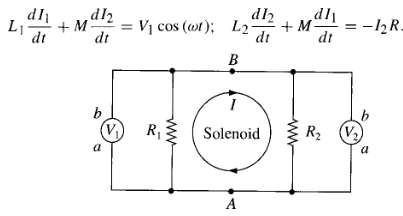A transformer (Prob. 7.53) takes an input AC voltage of amplitude V1, and delivers an output voltage
Question:
A transformer (Prob. 7.53) takes an input AC voltage of amplitude V1, and delivers an output voltage of amplitude V2, which is dete nnined by the turns ratio (V2/V1 = N2/N1). If N2 > N1 the output voltage is greater .than the input voltage. Why doesn't this violate conservation of energy?
(a) In an ideal transformer the same flux passes through all turns of the primary and of the secondary. Show that in this case M2 = L1L2, where M is the mutual inductance of the coils. and L1, L2 are their individual self-inductances.
(b) Suppose the primary is driven with AC voltage Vin = V1 cos (wt), and the secondary is connected to a resistor, R. Show that the two currents satisfy, the relations
(c) Using the result in (a), solve these equations for I1(t) and I2(t). (Assume I1 has no DC component.)
(d) Show that the output voltage (Vout = 12R) divided by the input voltage (Vin) is equal to the turns ratio: Vout/Vin = N2/N1.
(e) Calculate the input power (Pin = VinI1 and the output power (Pout = Vout I2), and show that their averages over a full cycle are equal.

Step by Step Answer:






